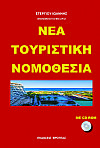ΚΑΤΗΓΟΡΙΕΣ
NEWSLETTER
Συπληρώστε το email σας
για να λάβετε τις προσφορές
και τα νέα της Bookstation
ΝΕΟΙ ΤΙΤΛΟΙ
-
Νέος Κώδικας για Δημόσιες Συμβάσεις ... -10η έκδοση-ΔΩΡΕΑΝ ΤΑ ΕΞΟΔΑ ΑΠΟΣΤΟΛΗΣ
Κωτσοβίνος Ευαγ. Βασίλης προσθήκη στο καλάθι
προσθήκη στο καλάθι
ISBN 978-618-845-981-6
Τιμή | 54 € -
Οι κωδικοί του Ε9 (Δήλωση Ακινήτων)-2024 -ΑΜΕΣΑ ΔΙΑΘΕΣΙΜΟ
Ορέστης Εμμ. Σεϊμένης-Μανούσος Ιωάν. Ντουκάκης προσθήκη στο καλάθι
προσθήκη στο καλάθι
ISBN 978-618-87035-0-6
Τιμή | 54 € -
Νέα τουριστική νομοθεσία 2024
Στεργίου Ιωάννης προσθήκη στο καλάθι
προσθήκη στο καλάθι
ISBN 978-618-5678-58-6
Τιμή | 76.5 €
περισσότερα >
Κατηγορίες / Offers / Medicine / pediatrics / Parasitology / Zika Virus

Zika Virus
Edited by Subhash C. Basak, Apurba K. Bhattacharjee, Ashesh Nandy
Εκδόσεις
Nova Science Publishers, Inc
ISBN: 978-153-614-970-8
Μετάφραση: DIAM.
Σελίδες: 127
Σχήμα: 17 x 24 εκ.
Εξώφυλλο: Softcover
Ημερομηνία έκδοσης: 26/03/2019
Τιμή | 92 €
The bubonic plague, smallpox, HIV/AIDS, malaria, and influenza are some of the worst epidemics/pandemics that afflicted human beings from antiquity to modern times, killing millions of people. The mosquito-borne human-infecting viruses, rotavirus, and the seasonal influenza regularly affect lives across continents in the millions. Currently, we are facing various disease-inducing organisms of the Flavivirus family ? the Yellow fever virus (YFV), West Nile virus (WNV), Japanese encephalitis virus (JEV), Tick-borne encephalitis virus (TBEV), Dengue virus (DENV) and Zika virus (ZIKV).
Zika virus was first isolated from a febrile rhesus monkey in the Zika forest of Uganda in 1947. It drew our heightened attention following the large number of microcephaly in newborn babies in Latin America in 2015. On 1 February 2016, WHO declared that the association of Zika infection with clusters of microcephaly and other neurological disorders constituted a Public Health Emergency of International Concern. Although the severity and number of ZIKV afflicted cases have gone down lately, the public health community worldwide is keeping a watchful eye on it.
ZIKV is an enveloped virus with a positive-sense RNA genome that translates into a single polypeptide, which then gets cleaved into three structural and seven nonstructural viral proteins. As compared to the earlier centuries, we have an expanding repertoire of diverse and fast acting technologies available at our hand to manage and mitigate emerging diseases. Completion of the Human Genome Project has given rise to sequencing methods which can quickly determine the genetic sequence of an alarming pathogen. Following Moore?s law, the power of computers, essential for data analysis and visualization, has grown substantially with time. The combination of genomic data of pathogens, computational modeling methods, and data driven methodologies can lead to a "generic approach" of surveillance, mitigation, vaccine design as well as new drug discovery for emerging pathogens. The four pillars of this may consist of:
a) Epidemiological approaches for the characterization of carriers of next possible emerging pathogens;
b) Fast computational sequence comparison methods for the characterization of emerging pathogens to understand how novel or severe they could be;
c) Once the sequences of the pathogen have been determined, computer-aided vaccine design (CAVD) methods can be used to suggest a set of probable vaccine candidates for quick synthesis and testing in the laboratory; and
d) Computer-assisted design of novel therapeutics and their laboratory testing as well as repurposing of already existing FDA-approved drugs.
A combination of different classes of methods ? in vivo, in vitro and in silico ? will be needed to tackle suddenly emerging viruses like the Zika virus. As in many other fields of biomedical research, high throughput and low cost in silico technologies may provide the first line of defense against such emerging pathogens providing decision support systems for the judicious applications of medium throughput in vitro methods and low throughput as well as costly in vivo techniques.
An emerging trend in many scientific disciplines is a strong tendency of being transformed into some form of information science. The editors of this book sincerely hope that the four-pronged computer-assisted approach described in this book will help in managing and mitigating emerging infectious diseases like Zika.
ΑΝΑΖΗΤΗΣΗ
Σε όλες τις κατηγορίες
ΑΝΑΚΟΙΝΩΣΕΙΣ
5/9/2012 2:16:56 PM
περισσότερα >
BEST SELLERS
-
Λατινικά ...για 20! (για τη Γ' Λυκείου)
Χρήστος Ζηκούλης προσθήκη στο καλάθι
προσθήκη στο καλάθι
ISBN 978-618-5837-00-6
Τιμή | 50 € -
Λατινικά...για 20! (Για τη Β' λυκείου)
Χρήστος Ζηκούλης προσθήκη στο καλάθι
προσθήκη στο καλάθι
ISBN 978-618-86835-9-4
Τιμή | 25 € -
Μάθε το επάγγελμα που σου ταιριάζει (2024)
Χρήστος Αθ. Ζηκούλης προσθήκη στο καλάθι
προσθήκη στο καλάθι
ISBN 978-618-86835-4-9
Τιμή | 30 € -
Ανακάλυψε τη σχολή που σου αξίζει (2024)
Ζηκούλης, Χρήστος Αθ. προσθήκη στο καλάθι
προσθήκη στο καλάθι
ISBN
Τιμή |40,0036,00 € -
Ανακάλυψε τη σχολή που σου αξίζει (2024)
Ζηκούλης, Χρήστος Αθ. προσθήκη στο καλάθι
προσθήκη στο καλάθι
ISBN
Τιμή |50,0045,00 € -
Ανακάλυψε τη σχολή που σου αξίζει (2024)
Ζηκούλης, Χρήστος Αθ. προσθήκη στο καλάθι
προσθήκη στο καλάθι
ISBN
Τιμή |35,0031,50 €
περισσότερα >

